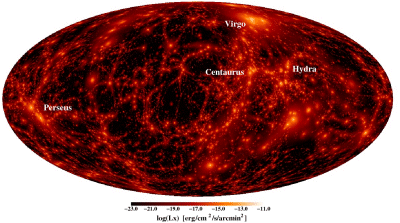| The Magneticum Pathfinder simulations are complemented with a set of additional simulations, which allow to test the effect of physical sub-grid models on the evolution of galaxies and galaxy clusters as well as to investigate the effects of the prominent structures in the local universe on observables. | ||||
COMPASS |
||||




|
COMPASS ClustersWith the aim to study in detail the interaction of galaxies with the ICM as well as microphysical processes like the evolution of magnetic fields, turbulence and cosmic rays within the ICM we extending the Dianoga simulations to far higher resolution. The aim is have 250 time more (Phase I) and 2500 times more (Phase II) resolution elements. This pushes simulations of massive clusters to so far never reached precision. Dark matter particle masses in the simulations will be 3.3e6 Msol/h (250x) / 3.3e5 Msol/h (2500x) and softening for dark matter and gas particles will be 0.5 kpc/h (250x), 0.2 kpc/h (2500x). The clusters will therefore be described by more than 600,000,000 particles within the virial radius and typically the simulations will resolve 100,000 galaxies within individual clusters.
Download Movie g5503149 1920x1080 (52 MB), COMPASS GalaxiesWith the aim to study in detail the evolution of galaxies and especially the outskirts of the galactic halo, we extending the Dianoga simulations to include groups, massive field galaxies and normal galaxies to be simulated at very high resolution. The aim is to have 250 and 2500 time more resolution (Phase I) and even explore 25000 times more resolution (Phase II). This pushes simulations of galaxies to have dark matter particle masses of 3.3e4 Msol/h (25000x). A MW like galaxy will be therefore resolved with 20,000,000 particles within the virial radius.
Download Movie dfrogin239105 (250x) 1920x1080 (27 MB), DATA availabilityRaw simulation data will be made available on request.Interactive |

|
||
Relevant Publications:
|
||||
Local Universe Simulation |
||||

|
CoruscantCoruscant is a cosmological re-simulation of the local universe based on initial conditions reconstructed from the 1.2 muJ IRAS full sky survey. This simulation is designed to represent the observed local neighborhood out ca. 110Mpc and makes it possible to identify prominent halos from the simulations with real observed galaxy clusters. This simulation includes various physical processes and is also part of the PLANCK sky model. There is a version of the simulation available which includes exactly the same sub-grid models than used in the Magneticum Pathfinder set of simulations. |
|||
Relevant Publications:
|
||||
Cluster re-simulations |
||||
Dianoga ClusterWith the aim to understand the formation of galaxy clusters and especially the impact of the gas physics and the feedback processes involved on the evolution of the intra cluster medium, we performed high-resolution zoom simulations of a set of mass limited galaxy clusters selected from a large cosmological box (Gpc in size) described with the standard WMAP-7 LCDM cosmological parameters. We produced 24 Lagrangian regions extracted around the most massive clusters. For each of these regions, initial conditions have been re-generated by increasing mass resolution and adding high-frequency modes, while progressively degrading resolution in outer regions. For each cluster, initial conditions have been generated at the level of the hr resolutions of the Magenticum Pathfinder simulations. These simulations are used to test the implementation of new physical modules and to quantify the impact of the sub-grid models on the intra cluster medium. The left image shows the position of the 24 clusters in the large box. If you click on it, you get a detailed visualization of all 24 clusters. |

|
|||
Relevant Publications:
|
||||
Galaxy re-simulation |
||||

|
Dianoga GalaxiesWith the aim to understand the formation of galaxies and especially the impact of the gas component and the feedback on the evolution of elliptical galaxies in various cosmological environments, we performed high-resolution zoom simulations of galaxies selected from a large cosmological box (Gpc in size). These simulations are also used to test the parameters of the sub-grid models used in the Magneticum Pathfinder simulations. The image on the left shows a massive galaxy forming inside a void structure at present day.Download Movie 1920x1080 (27MB) | |||
| Relevant Publications: | ||||
